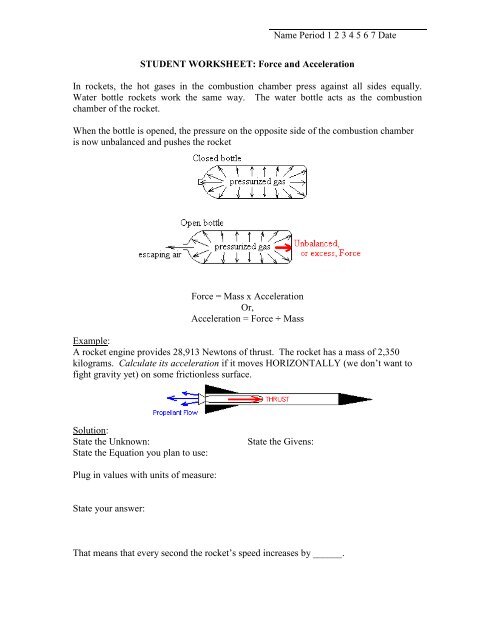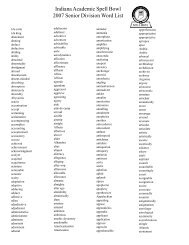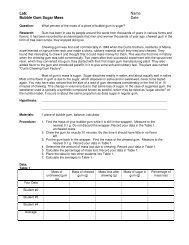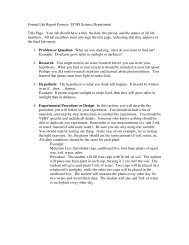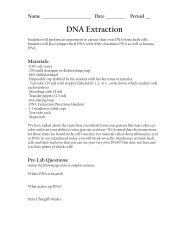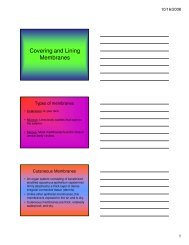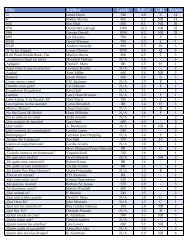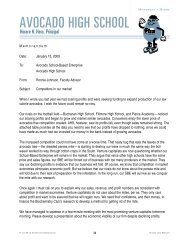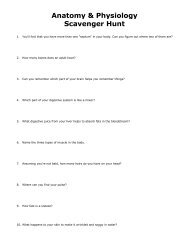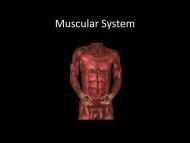STUDENT WORKSHEET: Force and Acceleration
STUDENT WORKSHEET: Force and Acceleration
STUDENT WORKSHEET: Force and Acceleration
- No tags were found...
You also want an ePaper? Increase the reach of your titles
YUMPU automatically turns print PDFs into web optimized ePapers that Google loves.
Name Period 1 2 3 4 5 6 7 Date<strong>STUDENT</strong> <strong>WORKSHEET</strong>: <strong>Force</strong> <strong>and</strong> <strong>Acceleration</strong>In rockets, the hot gases in the combustion chamber press against all sides equally.Water bottle rockets work the same way. The water bottle acts as the combustionchamber of the rocket.When the bottle is opened, the pressure on the opposite side of the combustion chamberis now unbalanced <strong>and</strong> pushes the rocket<strong>Force</strong> = Mass x <strong>Acceleration</strong>Or,<strong>Acceleration</strong> = <strong>Force</strong> ÷ MassExample:A rocket engine provides 28,913 Newtons of thrust. The rocket has a mass of 2,350kilograms. Calculate its acceleration if it moves HORIZONTALLY (we don’t want tofight gravity yet) on some frictionless surface.Solution:State the Unknown:State the Equation you plan to use:State the Givens:Plug in values with units of measure:State your answer:That means that every second the rocket’s speed increases by ______.
<strong>STUDENT</strong> <strong>WORKSHEET</strong>: <strong>Force</strong> <strong>and</strong> <strong>Acceleration</strong> Exercisesa. Using F = m × a1. Your bicycle has a mass of 9.1 kilograms. You accelerate at a rate of 1.79m/s 2 . Calculate the net force that is accelerating the bicycle.2. The Space Shuttle has a liftoff mass of 2,041,000 kg <strong>and</strong> accelerates at a rateof 16 m/s 2 . Calculate the force (thrust) that is accelerating the Space Shuttle.3. A rocket accelerates at 56 m/s 2 . It has a mass of 800,000 kg. Calculate theforce (thrust) that the rocket engines must supply.b. Using a = F ÷ m1. A runner has a mass of 89 kilograms. He produces a force of 84 Newtonsbetween the ground <strong>and</strong> his running shoes. How fast does he accelerate?2. Calculate the acceleration of a car if the force on the car is 450 Newtons <strong>and</strong>the mass is 1300 kilograms.3. Calculate the acceleration of a jet car racing on the Bonneville Salt Flats if theforce on it (the “Thrust”) is 500,000 Newtons <strong>and</strong> the mass is 2,100kilograms.
<strong>STUDENT</strong> <strong>WORKSHEET</strong>: Fighting Gravity!If we fire a rocket vertically, its acceleration will be a bit less since it must struggleagainst gravity.For vertical ascent (neglecting air resistance):a rocket = F total m rocketIf the rocket moves vertically, it sees (experiences) two forces: the upwardthrust of 120 Newtons, <strong>and</strong> the downward pull of gravity, which is just therocket’s weight, let’s say 15 Newtons (which is a mass of roughly 1.5kilograms).Solve:<strong>Acceleration</strong> = <strong>Force</strong> ÷ Mass<strong>Acceleration</strong> = (120 Newtons – 15 Newtons) ÷ (1.5 kilograms)<strong>Acceleration</strong> = 70 meters per second per secondNow you try a similar problem:A water bottle rocket has a mass of 0.248 kilograms. On Earth, this is a weight of2.43 Newtons. When the water sprays out the bottom of the bottle rocket, it creates astarting thrust of 77 Newtons. Calculate the water rocket’s starting acceleration:<strong>Acceleration</strong> = <strong>Force</strong> / Mass<strong>Acceleration</strong> = ( − ) / ( )<strong>Acceleration</strong> = ( ) / ( )<strong>Acceleration</strong> = _________________ meters per second squared


